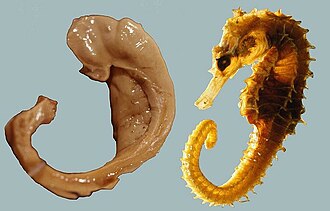Hippocampus
Part of the brain involved in memory and navigation
Hippocampus[edit]
The hippocampus is a major component of the brain of humans and other vertebrates. It belongs to the limbic system and plays important roles in the consolidation of information from short-term memory to long-term memory, and in spatial memory that enables navigation.

Anatomy[edit]
The hippocampus is located in the medial temporal lobe of the brain, underneath the cortical surface. It has a distinctive curved shape that has been likened to a seahorse, which is reflected in its name derived from the Greek words "hippos" (horse) and "kampos" (sea monster).

The hippocampus consists of two main interlocking parts: the Ammon's horn and the dentate gyrus. The Ammon's horn is further divided into subfields CA1, CA2, CA3, and CA4, each with distinct cellular compositions and functions.
Function[edit]
The primary function of the hippocampus is in the formation of new memories and is also associated with learning and emotions. It is particularly important for declarative memory, which involves facts and events, and spatial memory, which involves the ability to navigate and remember locations.

Memory[edit]
The hippocampus is crucial for the formation of new memories. Damage to the hippocampus can result in anterograde amnesia, where the ability to form new memories is impaired, while older memories remain intact.
[edit]
The hippocampus is involved in spatial navigation and memory. It helps in the formation of cognitive maps, which are mental representations of physical locations.

Pathology[edit]
Damage to the hippocampus can result from various conditions, including Alzheimer's disease, hypoxia, encephalitis, or temporal lobe epilepsy. Such damage can lead to memory deficits and difficulties in spatial navigation.
Research[edit]
Research on the hippocampus has been extensive, with studies ranging from its role in memory and learning to its involvement in neurogenesis and plasticity. The hippocampus is one of the few regions of the brain where new neurons are generated throughout life.

Comparative Anatomy[edit]
The structure and function of the hippocampus are conserved across many species, including mammals, birds, and reptiles. In macaques, the hippocampus is similarly involved in memory and spatial navigation.

Historical Perspective[edit]
The study of the hippocampus has a rich history, with significant contributions from scientists such as Santiago Ramón y Cajal, who provided detailed drawings of its structure.

Neuroanatomy[edit]
The hippocampus is part of the archicortex, one of the oldest parts of the brain in evolutionary terms. It is connected to other parts of the brain through the fornix and receives input from the entorhinal cortex.

Related pages[edit]
Ad. Transform your life with W8MD's Budget GLP-1 injections from $75


W8MD offers a medical weight loss program to lose weight in Philadelphia. Our physician-supervised medical weight loss provides:
- Weight loss injections in NYC (generic and brand names):
- Zepbound / Mounjaro, Wegovy / Ozempic, Saxenda
- Most insurances accepted or discounted self-pay rates. We will obtain insurance prior authorizations if needed.
- Generic GLP1 weight loss injections from $75 for the starting dose.
- Also offer prescription weight loss medications including Phentermine, Qsymia, Diethylpropion, Contrave etc.
NYC weight loss doctor appointmentsNYC weight loss doctor appointments
Start your NYC weight loss journey today at our NYC medical weight loss and Philadelphia medical weight loss clinics.
- Call 718-946-5500 to lose weight in NYC or for medical weight loss in Philadelphia 215-676-2334.
- Tags:NYC medical weight loss, Philadelphia lose weight Zepbound NYC, Budget GLP1 weight loss injections, Wegovy Philadelphia, Wegovy NYC, Philadelphia medical weight loss, Brookly weight loss and Wegovy NYC
|
WikiMD's Wellness Encyclopedia |
| Let Food Be Thy Medicine Medicine Thy Food - Hippocrates |
Medical Disclaimer: WikiMD is not a substitute for professional medical advice. The information on WikiMD is provided as an information resource only, may be incorrect, outdated or misleading, and is not to be used or relied on for any diagnostic or treatment purposes. Please consult your health care provider before making any healthcare decisions or for guidance about a specific medical condition. WikiMD expressly disclaims responsibility, and shall have no liability, for any damages, loss, injury, or liability whatsoever suffered as a result of your reliance on the information contained in this site. By visiting this site you agree to the foregoing terms and conditions, which may from time to time be changed or supplemented by WikiMD. If you do not agree to the foregoing terms and conditions, you should not enter or use this site. See full disclaimer.
Credits:Most images are courtesy of Wikimedia commons, and templates, categories Wikipedia, licensed under CC BY SA or similar.
Translate this page: - East Asian
中文,
日本,
한국어,
South Asian
हिन्दी,
தமிழ்,
తెలుగు,
Urdu,
ಕನ್ನಡ,
Southeast Asian
Indonesian,
Vietnamese,
Thai,
မြန်မာဘာသာ,
বাংলা
European
español,
Deutsch,
français,
Greek,
português do Brasil,
polski,
română,
русский,
Nederlands,
norsk,
svenska,
suomi,
Italian
Middle Eastern & African
عربى,
Turkish,
Persian,
Hebrew,
Afrikaans,
isiZulu,
Kiswahili,
Other
Bulgarian,
Hungarian,
Czech,
Swedish,
മലയാളം,
मराठी,
ਪੰਜਾਬੀ,
ગુજરાતી,
Portuguese,
Ukrainian